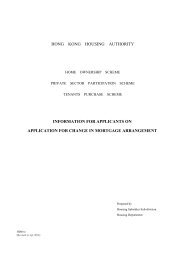The Hong Kong Housing Authority and its Financial Arrangement ...
The Hong Kong Housing Authority and its Financial Arrangement ...
The Hong Kong Housing Authority and its Financial Arrangement ...
Create successful ePaper yourself
Turn your PDF publications into a flip-book with our unique Google optimized e-Paper software.
<strong>The</strong> <strong>Hong</strong> <strong>Kong</strong> <strong>Housing</strong> <strong>Authority</strong> <strong>and</strong> <strong>its</strong><strong>Financial</strong> <strong>Arrangement</strong> over the Past 50 YearsEddie C.M. HUI <strong>and</strong> Francis K.W. WongDepartment of Building <strong>and</strong> Real Estate, <strong>The</strong> <strong>Hong</strong> <strong>Kong</strong> Polytechnic UniversityHKSAR, ChinaAbstract<strong>Hong</strong> <strong>Kong</strong> is renowned for <strong>its</strong> extensive public housing programme. Since 1973, the restructured<strong>Hong</strong> <strong>Kong</strong> <strong>Housing</strong> <strong>Authority</strong> (HA) has had the overall responsibility for building, allocation <strong>and</strong>managing public housing. In the past decades it has performed <strong>its</strong> tasks with great success. However,in recent years it has met with serious challenges due to economic downturn <strong>and</strong> changes ofaspirations to housing among the people of <strong>Hong</strong> <strong>Kong</strong>. <strong>The</strong>refore, it will be of value to review thefinancial arrangement of HA <strong>and</strong> <strong>its</strong> predecessors over the past 50 years to provide insights to thefuture of HA. This paper will analyse three aspects of HA’s financial arrangements. Firstly, the changein financial tools <strong>and</strong> financial terms between the government <strong>and</strong> the HA in the past decades will beexamined. Secondly, the trends <strong>and</strong> patterns in the HA’s income <strong>and</strong> expenditure are scrutinized.Lastly, the financial sustainability of the HA is evaluated.1. IntroductionSince 1953, the <strong>Hong</strong> <strong>Kong</strong> government has supported public housing developmentthrough the direct injection of capital <strong>and</strong> indirect subsidies of l<strong>and</strong>. It has financed theconstruction of over 1.3 million domestic un<strong>its</strong> under public rental housing (PRH) <strong>and</strong>various subsidised-ownership programmes, which now accommodate about half of thepopulation in <strong>Hong</strong> <strong>Kong</strong>. <strong>The</strong> dimension of such development is no doubt very impressiveby international st<strong>and</strong>ards <strong>and</strong> these subsidised housing un<strong>its</strong> have benefited manyhouseholds in the last fifty years.Since 1973, the new <strong>Hong</strong> <strong>Kong</strong> <strong>Housing</strong> <strong>Authority</strong> (HA) has been overall responsiblefor the provision, allocation <strong>and</strong> management of public housing in order to meet society’sneed. Behind this long established mission, the HA has gone through major changes in <strong>its</strong>
Scheme (HPLS) was introduced in 1987. It offered low-interest down payment loans toeligible applicants to encourage them to purchase private-sector flats. In additions, the HAhad implemented various measures to ensure a more efficient control over subsidies,construction <strong>and</strong> estate management.2.5 Stage 5. Seeking sources of new funding (1997-2002)Since 1997, the HA has been working to respond to the government’s ambitions toincrease home ownership rate <strong>and</strong> speed up the allocation of PRH by building more HOS,PSPS, PRH <strong>and</strong> increase the quotas of HPLS. It is believed that the HOS will continue <strong>and</strong>more public housing will be sold to <strong>its</strong> existing tenants through the Tenants Purchase Scheme(TPS).Although there is no new funding from the government, the HA started a new way offinancing by selling <strong>its</strong> HPLS loans to the <strong>Hong</strong> <strong>Kong</strong> Mortgage Corporation, so that morefunds would be available for the HPLS. On the other h<strong>and</strong>, a greater private sectorinvolvement is evident in estate management <strong>and</strong> even in the development of public housing.With limited budget, the HA tried to make use of the private sector to take over thedevelopment <strong>and</strong> construction works <strong>and</strong> change <strong>its</strong> role from a developer to a facilitator forhousing provision.3 <strong>Financial</strong> trends <strong>and</strong> patternsGiven a brief review of the changes over time in financial arrangements between the
3.2.1. Operating expenditureIn the HA’s account, the major expenditure includes the construction, management <strong>and</strong>maintenance of PRH <strong>and</strong> the HOS estates, the redevelopment of resettlement housing <strong>and</strong>squatter clearance. <strong>The</strong> items of expenditure are set out in Table 5.Table 3 Items of expenditureGeneral ExpenditureExpenditureAmount HK$million% of totalexpenditurePersonal emoluments 3,666 12%Government rent <strong>and</strong> rates 1,641 5%Maintenance <strong>and</strong> improvements 3,218 11%Other expenditure 2,513 8%Depreciation 3,079 10%Share of corporate supervision <strong>and</strong> support 117 0%services expensesHome Ownership (HO) ExpenditureConstruction <strong>and</strong> overheads 10,275 34%L<strong>and</strong> formation cost 3,703 12%Other HO expenditure (incl. expenditure on 1,627 5%Repurchased flats sold <strong>and</strong> Interest on HPLSloans sold)Total 29,839Sources: <strong>Hong</strong> <strong>Kong</strong> <strong>Housing</strong> <strong>Authority</strong> Annual Report 2000/01Notes According to the 2000/01 consolidated operating account3.2.2. Debt repayment<strong>The</strong> HA has obtained capital <strong>and</strong> loans from the government over the years <strong>and</strong> the HAhas to repay part of it to the government. For the permanent capital, it is taken as thegovernment investment <strong>and</strong> the HA pays back the government with dividend. For the loans,the HA has to pay interest on the declining balance of the outst<strong>and</strong>ing principal.
4. <strong>Financial</strong> sustainabilityAfter looking into the sources of income <strong>and</strong> expenditure in public housing provision, it isfound that the HA’s financial sustainability will very much depends on:– whether the government will further inject capital to the HA,– the sustainability of rental income,– the future sales of properties,– social expectation of housing <strong>and</strong>– the need for large scale redevelopment <strong>and</strong> rehousing.In this section, the details of each of these aspects will be examined, followed by ananalysis of the overall financial sustainability of the HA.4.1. Government subsidiesIn the past, the government had subsidised the development of resettlement housing <strong>and</strong>Government Low-cost <strong>Housing</strong> through different government departments. Since the newHA was established, government has directly subsidised the HA to build PRH <strong>and</strong> HOS un<strong>its</strong>.All the funds needed could be obtained from the government. In 1988 when the HA becameself-financed, it started to raise fund for <strong>its</strong> own operation. Although the HA is still gettingfinancial support from government through free l<strong>and</strong> <strong>and</strong> capital loans, the current
unfavourable economy has limited the room for future funding available from thegovernment.4.2. Rental incomeA low rent policy was employed in setting rent for PRH, it aimed at keeping down thecost of living <strong>and</strong> in turns reduced production cost. Before the 1980s, the rent forresettlement housing has long been lower than the realistic level, with less than 10% of thehousehold budget. For the newly developed estate, the rent level is higher but it seldomrises over 10% of the household expenditure.With the long-established low rent policy, it is difficult for the HA to substantially raisethe rent level to offset <strong>its</strong> deficit. Besides, a rent cap was implemented in 1997, thuswhenever there is a rent review, the Median Rent to Income Ratio (MRIR) of the PRH cannotbe more than 10%. <strong>The</strong> <strong>Housing</strong> Ordinance requires the HA to ensure that revenue meetsexpenditure on estates. However, the rent cap was in conflict with this provision <strong>and</strong> mayforce the HA to operate <strong>its</strong> PRH under a deficit (Ng 2002).4.3. Sales of properties<strong>The</strong> sale of HOS has been an important source of income. Its contribution increasedfrom 46% in the early 1990s to 55% in the mid-1990s <strong>and</strong> further rise to 66% in recent years.However, the government has decided to indefinitely suspended the building <strong>and</strong> selling of
HOS flats, the HA may have to look for other sources of income or ask for more fundingfrom the government in order to keep sufficient cash flow.4.4. Social expectation of housingWith limited budget, it is hard for the HA to meet the ever growing aspiration onimproved quality of living (Lau & Yip, 1996). <strong>The</strong>refore, the HA may have to look forother means to provide cost effective <strong>and</strong> efficient services. In future, more estatemanagement <strong>and</strong> maintenance will be outsourced from the private sector. Besides, theimprovement projects for shopping centres <strong>and</strong> the valuation work of premium assessmentsfor HOS/PSPS flats could be contracted out to the private sector. <strong>The</strong>se arrangements areexpected to reduce the HA’s expenditure <strong>and</strong> at the same time improve the quality ofservices.
4.5. Redevelopment <strong>and</strong> rehousing<strong>The</strong> redevelopment of resettlement housing <strong>and</strong> squatter clearance involves a hugeamount of money. However, there are only 36,000 un<strong>its</strong> of former resettlement housing left<strong>and</strong> the last squatter area in Diamond Hill was cleared in 2001, the expenditure on theredevelopment of PRH will be lowered in the coming years. Thus, it reduces the pressureon the HA’s financial burden.4.6. Overall financial sustainability<strong>The</strong> current finance of the HA is remaining positive, with over $63,000 million reserves<strong>and</strong> $50,000 million funds, <strong>and</strong> an operating surplus of over $11,000 million in 2000/01.But <strong>its</strong> future financial sustainability is dependent upon the government housing strategy,which determined the role of the HA, <strong>and</strong> balance between the HA’s income <strong>and</strong> expenditure.Recently, the <strong>Housing</strong> Bureau has been transformed to the <strong>Housing</strong>, Planning <strong>and</strong> L<strong>and</strong>sBureau <strong>and</strong> the <strong>Housing</strong> Department is undergoing an evaluation <strong>and</strong> a restructuring will becarried out in the near future. <strong>The</strong>se reorganisations are believed to help the HA to retrieve<strong>its</strong> role <strong>and</strong> set out <strong>its</strong> long-term vision. With a clear position, the HA can better plan <strong>its</strong>future finance so as to maintain <strong>its</strong> financial sustainability.
5. ConclusionThis paper has reviewed the financial arrangement for public housing provision in thepast fifty years. Through the financial trends <strong>and</strong> patterns, the financial sustainability of theHA is examined.It is found that in these fifty years, the <strong>Hong</strong> <strong>Kong</strong> government has a significantcontribution to the public housing development. It sets out different housing policies tomeet society needs <strong>and</strong> enhance economic prosperity. <strong>The</strong> HA is the major institution tohelp with the implementation of housing policy, it turns government’s funding into housingsubsidies in kind or in monetary subsidies, providing rental housing, various subsidised flatfor sale <strong>and</strong> loans for home purchase.In the long-term, the financial sustainability of the HA will depends on the availability ofgovernment’s extra funding or new means of income. <strong>The</strong> HA has been working in a costefficient <strong>and</strong> effective way of estate management <strong>and</strong> maintenance, <strong>and</strong> exploring newsources of funding such as the sale of HPLS loans to the <strong>Hong</strong> <strong>Kong</strong> Mortgage Corporation<strong>and</strong> the privatisation of <strong>its</strong> retail <strong>and</strong> car parking businesses. <strong>The</strong> HA has been acting as amanager of public housing, with more outsourcing <strong>and</strong> privatisation of <strong>its</strong> function, the HA isbecoming more like a facilitator for housing provision. Although the HA’s scope of workmay be reduced, it will probably continue to have a major role to play in terms of publichousing provision in <strong>Hong</strong> <strong>Kong</strong>.
ReferencesCastells M, Goh L, Kwok R Y-W (1990) <strong>The</strong> Shek Kip Mei Syndrome: EonomicDevelopment <strong>and</strong> Public <strong>Housing</strong> in <strong>Hong</strong> <strong>Kong</strong> <strong>and</strong> Singapore, London: Pion LimitedDrakakis-Smith, David (1979) High Society: <strong>Housing</strong> Provision in <strong>Hong</strong> <strong>Kong</strong> 1954 to 1979A Jubilee Critique, <strong>Hong</strong> <strong>Kong</strong>: Centre of Asian Studies, University of <strong>Hong</strong> <strong>Kong</strong>Government of <strong>Hong</strong> <strong>Kong</strong> (1972) <strong>The</strong> full text of the speech given to the Legislative Councilon October 18 th 1972 by His Excellency <strong>The</strong> Governor Sir Murray MacLehose, KCMG,MBE, <strong>Hong</strong> <strong>Kong</strong>: <strong>Hong</strong> <strong>Kong</strong> Government Printer<strong>Hong</strong> <strong>Kong</strong> <strong>Housing</strong> <strong>Authority</strong>, <strong>Hong</strong> <strong>Kong</strong> <strong>Housing</strong> <strong>Authority</strong> Annual Report, various issues,<strong>Hong</strong> <strong>Kong</strong>: <strong>Hong</strong> <strong>Kong</strong> <strong>Housing</strong> <strong>Authority</strong>Lau, Kwok Yu <strong>and</strong> Yip, Ngai Ming (1996) “Affordability <strong>and</strong> Rent policy in the Public<strong>Housing</strong> Sector in <strong>Hong</strong> <strong>Kong</strong>”, <strong>Housing</strong> for Millions Conference Papers, pp. 102-106Leung, Mei-yee (1999) From Shelter to Home, <strong>Hong</strong> <strong>Kong</strong>: <strong>Hong</strong> <strong>Kong</strong> <strong>Housing</strong> <strong>Authority</strong>Ng, Kang-chung (2002) “Tenants win aid to test rent breach”, <strong>The</strong> St<strong>and</strong>ard, 27 April.© “2004, Eddie C.M. Hui <strong>and</strong> Francis Wong, <strong>Hong</strong> <strong>Kong</strong>”. This conference paper is extracted from abook chapter by the same two authors for the 50 th anniversary of the <strong>Hong</strong> <strong>Kong</strong> <strong>Housing</strong> <strong>Authority</strong> in2003.All rights reserved. No part of this paper may be reproduced, distributed, published, or transmittedwithout the prior permission of the copyright owner.


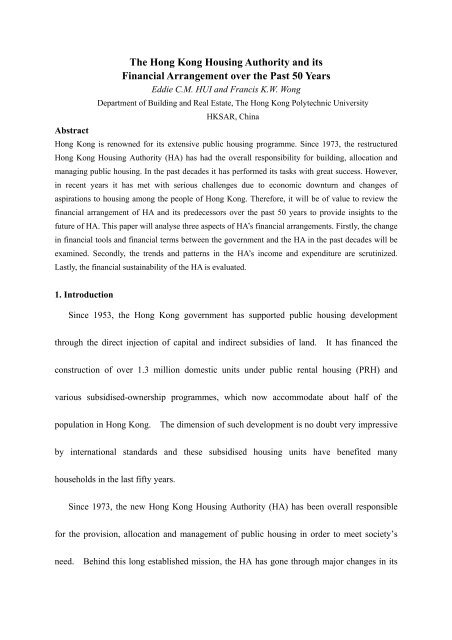
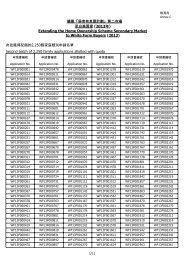

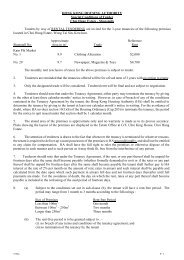
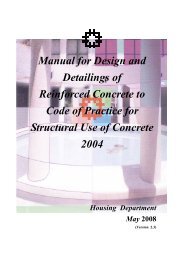


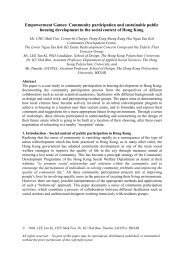
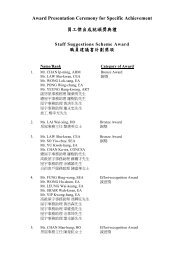
![Information for Applicants [HD273] (PDF format)](https://img.yumpu.com/34257587/1/184x260/information-for-applicants-hd273-pdf-format.jpg?quality=85)
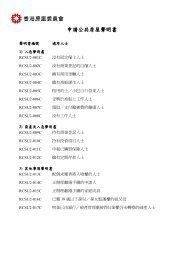

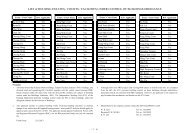
![å
¬å±è¼ªååç³è«é ç¥[HD274] (PDF æ ¼å¼) - é¦æ¸¯æ¿å±å§å¡æåæ¿å±ç½²](https://img.yumpu.com/31499087/1/184x260/aae-1-4-aacee-chd274-pdf-ae-1-4-a-1-4-eaeaeaaaaeaaeac-1-2-.jpg?quality=85)
